Abstract
Cadmium induced renal tubular effects were examined in 65 female workers in a factory manufacturing nickel cadmium batteries. Urinary beta 2-microglobulin (beta 2m), urinary N-acetyl-D-glucosaminidase activity (NAG), and serum creatinine and serum urea concentrations were used to assess the renal effects. Of the four measures, only urinary NAG and urinary beta 2m showed a strong positive correlation with blood cadmium concentrations (r = 0.49 and 0.43 respectively); NAG showed a weaker correlation with urinary cadmium concentrations (r = 0.35). Urinary beta 2m has weak correlation with urinary cadmium (r = 0.04). Only urinary NAG showed a significant deterioration in renal function among the exposed group. NAG detects the largest proportion of abnormalities among the exposed group. Abnormal urinary beta 2m is detected in only 15.4% of the workers, half of whom have blood cadmium above 10 micrograms/l. The proportion of abnormalities detected by urinary NAG differs significantly from the proportion of abnormalities detected by urinary beta 2m (p less than 0.01). The age adjusted mean urinary NAG excretion showed a significant rise with urinary cadmium of above 3 micrograms/g creatinine. Urinary beta 2m failed to show any significant rise. With blood cadmium concentrations, the age adjusted mean urinary NAG excretion showed a rise from 1 microgram/l of blood cadmium followed by a plateau between blood cadmium concentrations of 3-10 micrograms/l. No significant rise in mean urinary excretion in beta 2m was seen until blood cadmium concentrations exceeded 10 micrograms/l.
Full text
PDF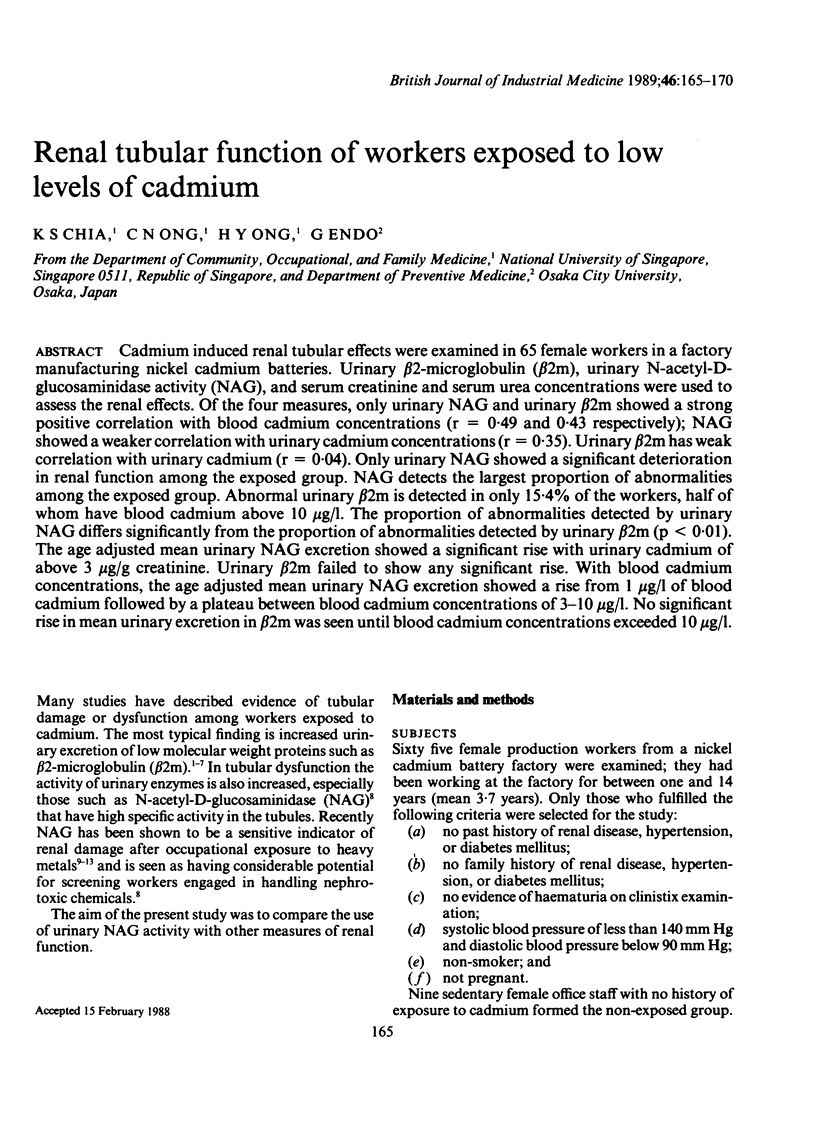
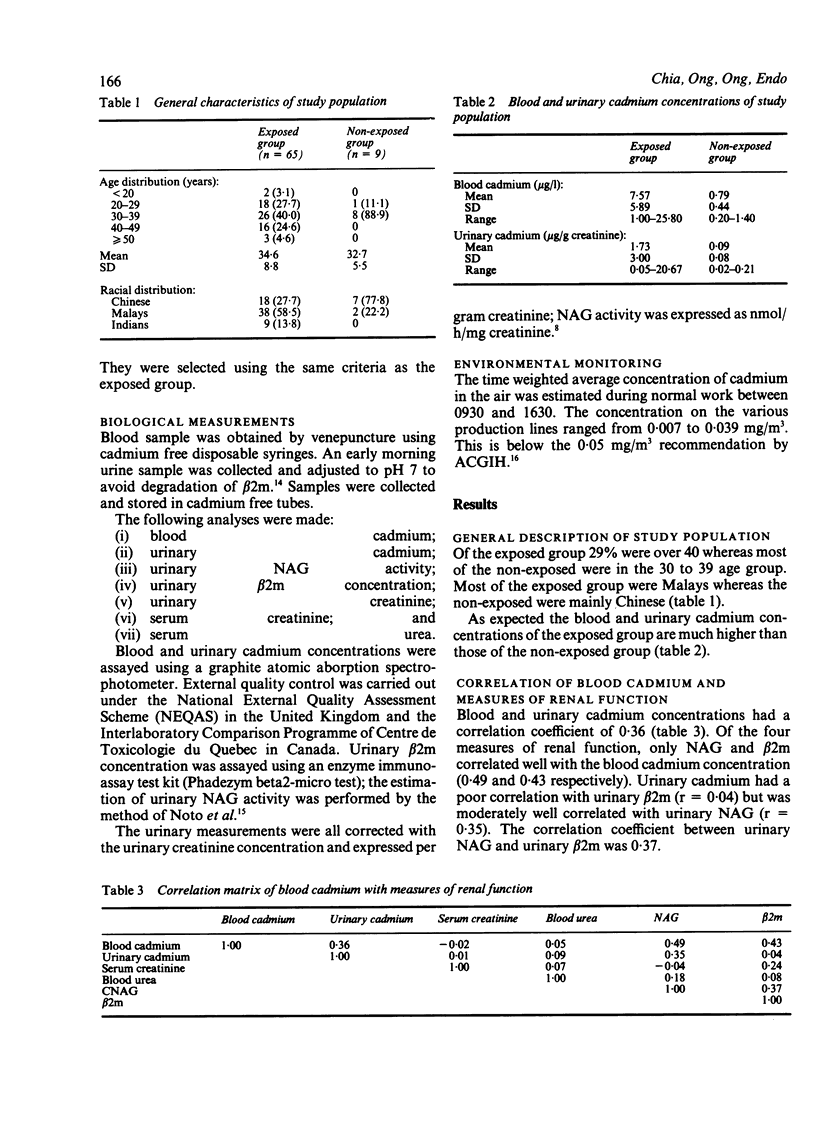
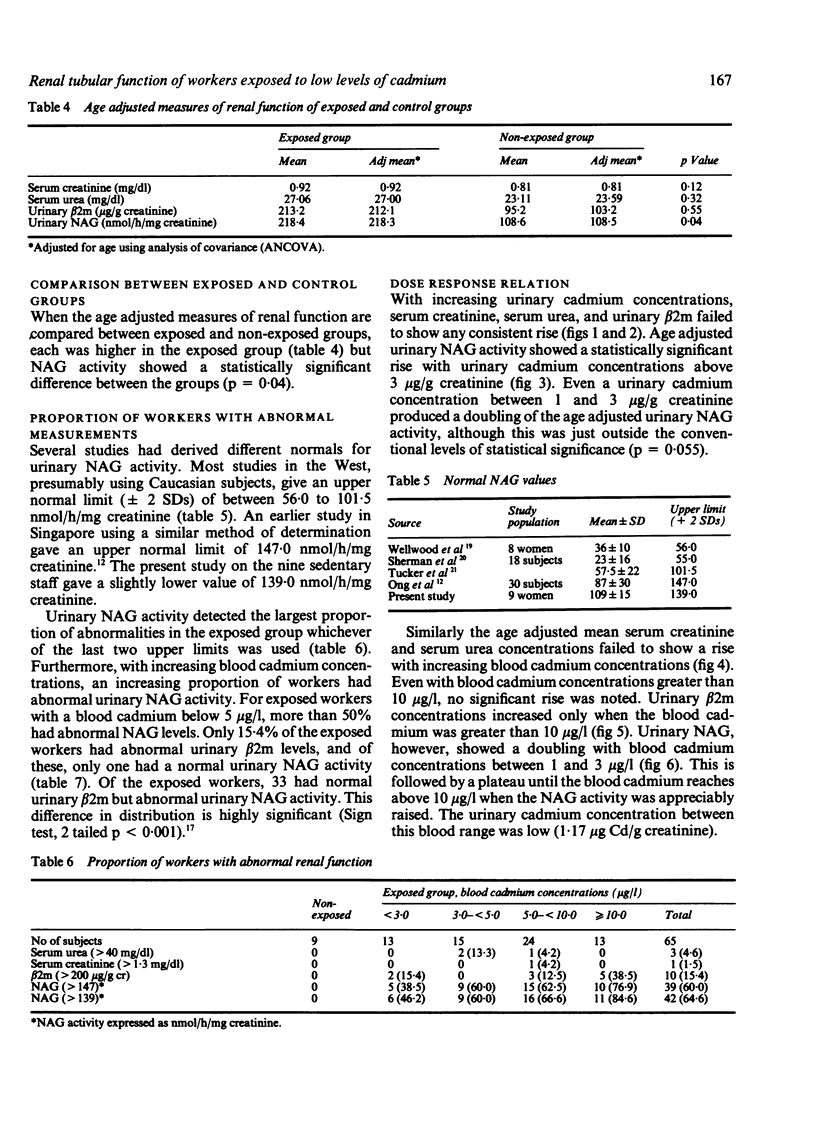
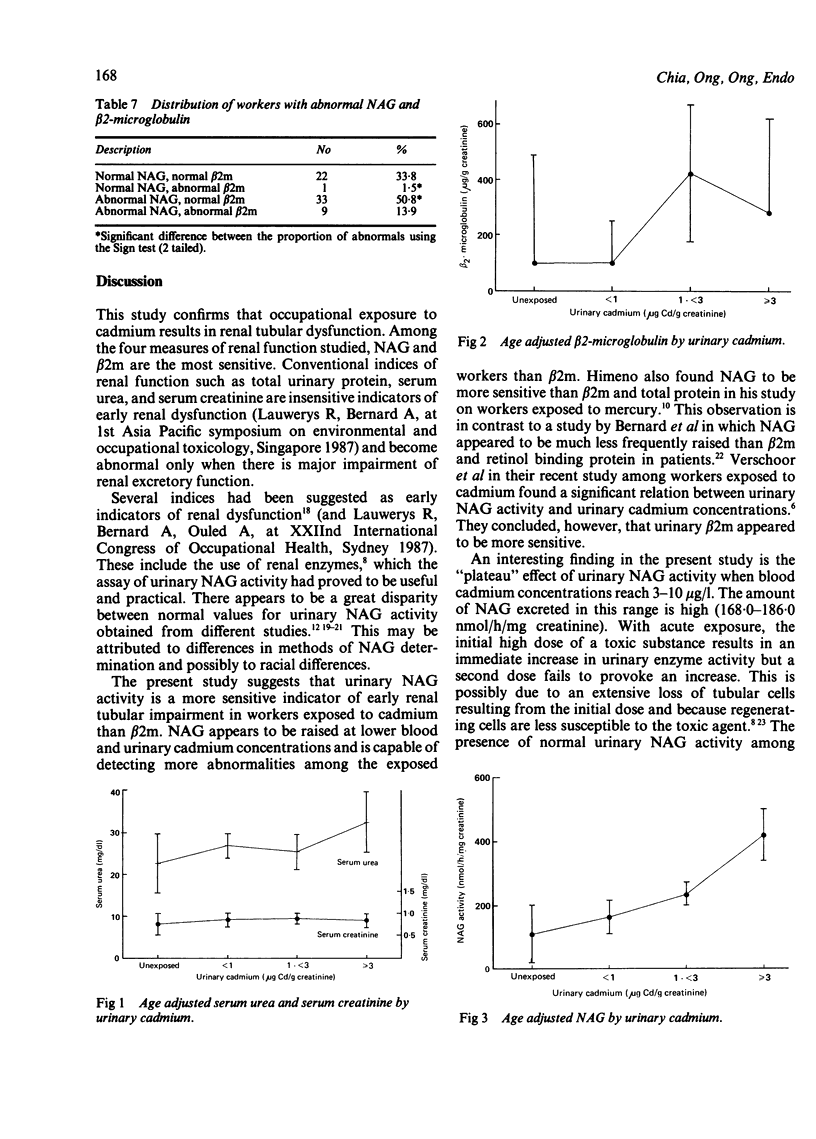

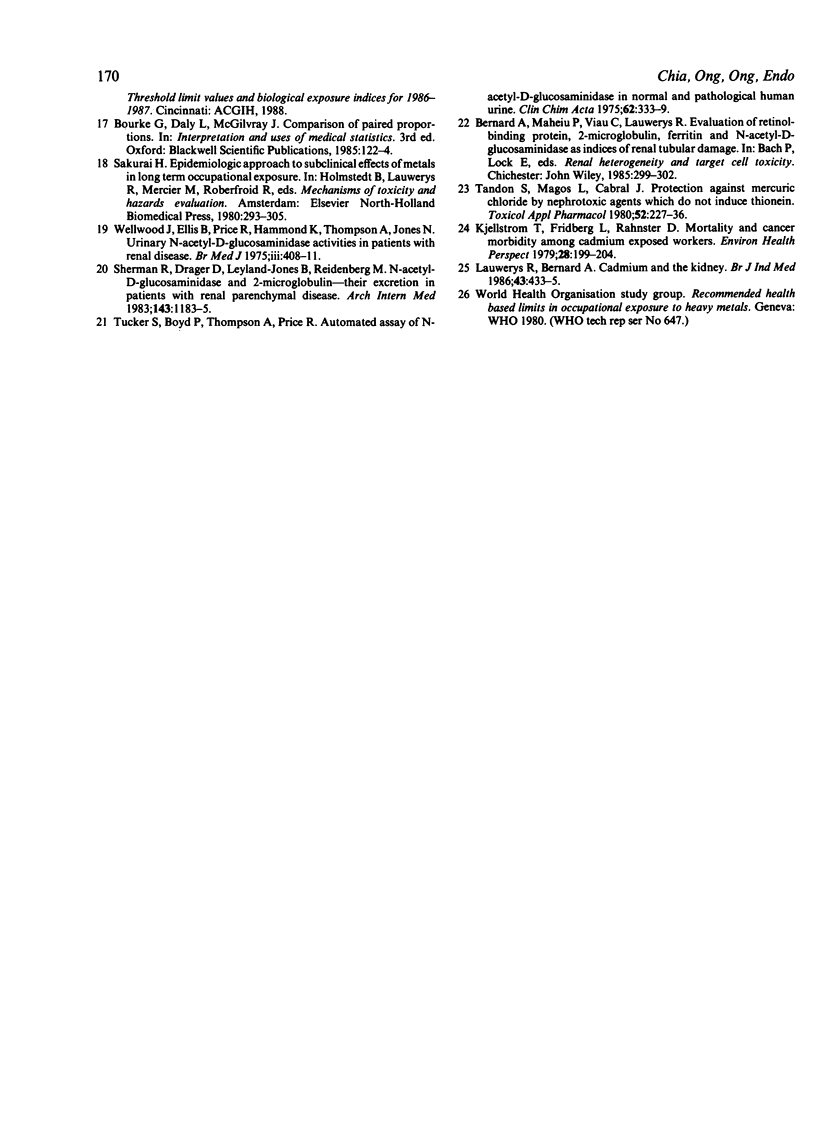
Selected References
These references are in PubMed. This may not be the complete list of references from this article.
- Buchet J. P., Roels H., Bernard A., Lauwerys R. Assessment of renal function of workers exposed to inorganic lead, calcium or mercury vapor. J Occup Med. 1980 Nov;22(11):741–750. [PubMed] [Google Scholar]
- Buell G. Some biochemical aspects of cadmium toxicology. J Occup Med. 1975 Mar;17(3):189–195. [PubMed] [Google Scholar]
- Elinder C. G., Edling C., Lindberg E., Kågedal B., Vesterberg O. Assessment of renal function in workers previously exposed to cadmium. Br J Ind Med. 1985 Nov;42(11):754–760. doi: 10.1136/oem.42.11.754. [DOI] [PMC free article] [PubMed] [Google Scholar]
- Elinder C. G., Edling C., Lindberg E., Kågedal B., Vesterberg O. beta 2-Microglobulinuria among workers previously exposed to cadmium: follow-up and dose-response analyses. Am J Ind Med. 1985;8(6):553–564. doi: 10.1002/ajim.4700080607. [DOI] [PubMed] [Google Scholar]
- FRIBERG L. Health hazards in the manufacture of alkaline accumulators with special reference to chronic cadmium poisoning; a clinical and experimental study. Acta Med Scand Suppl. 1950;240:1–124. [PubMed] [Google Scholar]
- Friberg L. Cadmium and the kidney. Environ Health Perspect. 1984 Mar;54:1–11. doi: 10.1289/ehp.84541. [DOI] [PMC free article] [PubMed] [Google Scholar]
- Himeno S., Watanabe C., Suzuki T. Urinary biochemical changes in workers exposed to mercury vapor. Ind Health. 1986;24(3):151–155. doi: 10.2486/indhealth.24.151. [DOI] [PubMed] [Google Scholar]
- Kjellström T., Friberg L., Rahnster B. Mortality and cancer morbidity among cadmium-exposed workers. Environ Health Perspect. 1979 Feb;28:199–204. doi: 10.1289/ehp.28-1637490. [DOI] [PMC free article] [PubMed] [Google Scholar]
- Lauwerys R. R., Bernard A. M. Cadmium and the kidney. Br J Ind Med. 1986 Jul;43(7):433–435. doi: 10.1136/oem.43.7.433. [DOI] [PMC free article] [PubMed] [Google Scholar]
- Meyer B. R., Fischbein A., Rosenman K., Lerman Y., Drayer D. E., Reidenberg M. M. Increased urinary enzyme excretion in workers exposed to nephrotoxic chemicals. Am J Med. 1984 Jun;76(6):989–998. doi: 10.1016/0002-9343(84)90847-7. [DOI] [PubMed] [Google Scholar]
- Noto A., Ogawa Y., Mori S., Yoshioka M., Kitakaze T., Hori T., Nakamura M., Miyake T. Simple, rapid spectrophotometry of urinary N-acetyl-beta-D-glucosaminidase, with use of a new chromogenic substrate. Clin Chem. 1983 Oct;29(10):1713–1716. [PubMed] [Google Scholar]
- Price R. G. Urinary enzymes, nephrotoxicity and renal disease. Toxicology. 1982;23(2-3):99–134. doi: 10.1016/0300-483x(82)90092-0. [DOI] [PubMed] [Google Scholar]
- Rosenman K. D., Valciukas J. A., Glickman L., Meyers B. R., Cinotti A. Sensitive indicators of inorganic mercury toxicity. Arch Environ Health. 1986 Jul-Aug;41(4):208–215. doi: 10.1080/00039896.1986.9938335. [DOI] [PubMed] [Google Scholar]
- Tandon S. K., Magos L., Cabral J. R. Protection against mercuric chloride by nephrotoxic agents which do not induce thionein. Toxicol Appl Pharmacol. 1980 Feb;52(2):227–236. doi: 10.1016/0041-008x(80)90109-x. [DOI] [PubMed] [Google Scholar]
- Tucker S. M., Boyd P. J., Thompson A. E., Price R. G. Automated assay of N-acetyl-beta-glucosaminidase in normal and pathological human urine. Clin Chim Acta. 1975 Jul 23;62(2):333–339. doi: 10.1016/0009-8981(75)90245-4. [DOI] [PubMed] [Google Scholar]
- Verschoor M., Herber R., van Hemmen J., Wibowo A., Zielhuis R. Renal function of workers with low-level cadmium exposure. Scand J Work Environ Health. 1987 Jun;13(3):232–238. doi: 10.5271/sjweh.2065. [DOI] [PubMed] [Google Scholar]
- Wellwood J. M., Ellis B. G., Price R. G., Hammond K., Thompson A. E., Jones N. F. Urinary N-acetyl- beta-D-glucosaminidase activities in patients with renal disease. Br Med J. 1975 Aug 16;3(5980):408–411. doi: 10.1136/bmj.3.5980.408. [DOI] [PMC free article] [PubMed] [Google Scholar]


